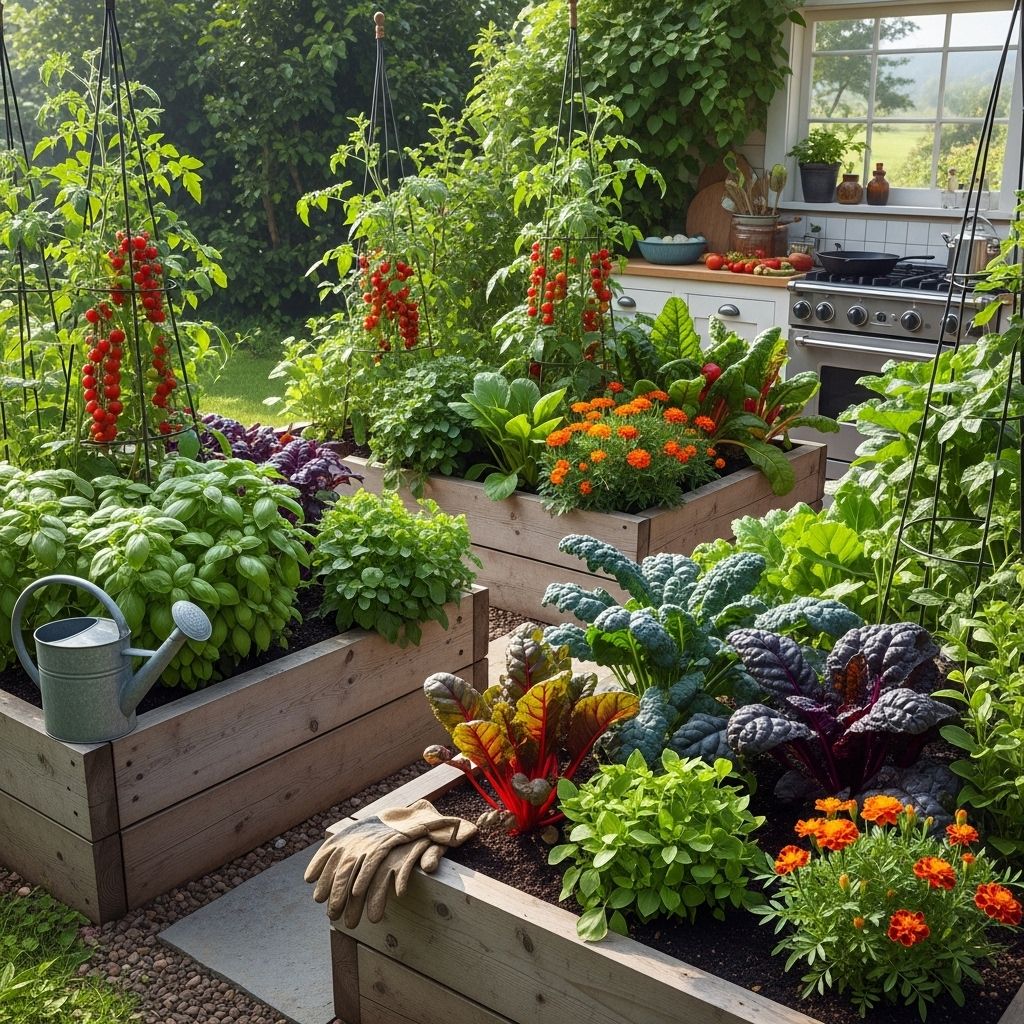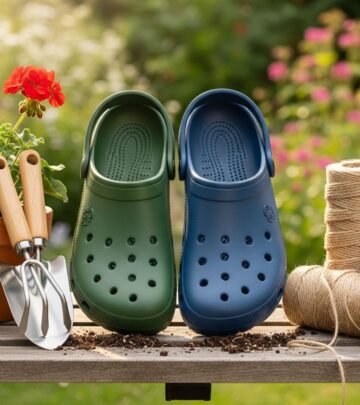Kitchen Garden Ideas: Expert Tips For A Lush, Productive Space
Transform your outdoor space into a thriving kitchen garden with expert advice, design inspiration, and practical planting strategies.

Image: HearthJunction Design Team
Transform Your Outdoor Space: Kitchen Garden Tips for Every Home
Imagine the convenience and satisfaction of stepping outside your kitchen to harvest crisp lettuce, juicy tomatoes, or fragrant herbs for tonight’s meal. A well-planned kitchen garden makes this possible, blending function and beauty while providing fresh, healthy produce right at your fingertips.
What Is a Kitchen Garden?
A kitchen garden, often known as a ‘potager,’ is a dedicated space where vegetables, herbs, and sometimes fruits and edible flowers are grown for household use. Unlike sprawling vegetable patches, a kitchen garden often emphasizes organization, aesthetics, and accessibility, designed to be as pleasing as it is productive.
Getting Started: Planning Your Kitchen Garden
- Start small, especially if you’re new to gardening. A few beds or containers are easier to manage and yield more reliable results.
- Consider your available space: backyard, side yard, patio, or even balcony containers can all become productive kitchen gardens.
- Choose a site with at least six hours of direct sunlight—most edible plants require ample sun for strong growth.
- Ensure easy access to water. A nearby outdoor tap or rain barrel makes tending your garden easier.
Soil Health: The Foundation of Success
Healthy, fertile soil is key to productive harvests. Before planting:
- Test the soil for nutrients and pH. Amend it as needed with compost or organic matter to improve structure and fertility.
- Mulch around plants to retain moisture, suppress weeds, and moderate soil temperature.
- Consider cover crops or green manures in the off-season to enrich the soil for the following year.
Designing Your Kitchen Garden: Inspiration and Layouts
Just as homes reflect the personalities of those who live in them, kitchen gardens can be tailored to your taste, space, and culinary preferences. Here are classic design ideas to inspire your layout:
Classic Four-Bed Layout
- Organize four raised beds in a symmetrical grid with clear pathways between them—perfect for form, function, and ease of maintenance.
- Dedicate each bed to a different plant group for effective crop rotation: roots (carrots, beets, potatoes), legumes (beans, peas), salad/herbs (lettuce, basil), and mixed crops (squash, corn, leafy greens).
- Symmetry not only looks beautiful but simplifies planning and navigation.
Twin Gardens and Other Raised Bed Ideas
- Two parallel beds (“twin gardens”) offer modern, efficient use of narrow spaces and blend well with home exteriors.
- Unique shapes like half-moon beds or keyhole gardens maximize space and add visual interest.
- Use vertical structures like arch trellises for vining crops, saving ground space and creating dramatic focal points.
Informal and Border Gardens
- If you prefer relaxed charm, mix edible plants with flowers in informal beds along fences or walkways.
- Container gardens are perfect for balconies, patios, or small yards. Mix culinary herbs, salad greens, or dwarf tomatoes in pots for easy access.
Pathways, Focal Points, and Accessories
- Include clear paths for convenient access, using materials like gravel, mulch, or stepping stones.
- Install a small central bed, garden ornament, or water feature in formal designs as a focal point.
- Consider adding a compost bin, rain barrel, or trellis to enhance the functions and sustainability of your garden.
Choosing What to Grow: Crop Selection for Kitchen Gardens
Your kitchen garden should reflect your cooking habits and family favorites. Consider these guidelines to select the best crops:
- Grow what you love to eat, focusing on high-value or high-turnover crops (lettuce, herbs, tomatoes, peppers).
- Mix vegetables, herbs, edible flowers, and even small fruits for diversity and resilience.
- Stagger plantings of quick-growing crops for regular harvests throughout the season.
- Rotate groups of plants each year to prevent pests and diseases from building up in the soil.
| Crop Category | Examples | Notes |
|---|---|---|
| Roots | Carrots, beets, radishes, potatoes | Deep, loose soil is best |
| Legumes | Beans, peas | Fix nitrogen in the soil; good after roots |
| Leafy Greens | Lettuce, spinach, chard, kale | Fast-growing; successive sowings prolong harvest |
| Solanaceae | Tomatoes, peppers, eggplant | Require sturdy supports and warmth |
| Herbs | Basil, parsley, thyme, chives | Perfect for borders and containers |
| Edible Flowers | Nasturtium, calendula, viola | Add color and attract pollinators |
Timing and Planting: Sowing the Seeds of Success
Understanding your local climate, last and first frost dates, and the needs of each plant ensures a continuous, bountiful harvest.
- Start cool-season crops (lettuce, spinach, peas) in early spring or late summer for fall crops.
- Plant warmth-loving crops (tomatoes, peppers, beans) after the danger of frost has passed.
- Try interplanting faster and slower maturing crops together to maximize bed usage.
- Stagger sowings of salad greens and herbs every few weeks for ongoing harvests.
Maintenance Tips for a Thriving Kitchen Garden
- Water deeply and consistently, aiming for the root zones; avoid over-watering which can lead to disease.
- Mulch beds with organic materials to suppress weeds, retain moisture, and moderate soil temperature.
- Practice crop rotation and companion planting to keep pests and diseases in check.
- Harvest regularly to encourage continued production, especially for cut-and-come-again crops like lettuce and herbs.
- Remove spent crops promptly, composting healthy residue and disposing of diseased material.
Organic Practices for Healthier Gardens
- Encourage beneficial insects by planting flowers and minimizing pesticide use.
- Make your own compost from kitchen and garden waste to feed your soil naturally.
- Rotate crops and diversify plantings to confuse pests and break disease cycles.
Year-Round Kitchen Gardening: Succession, Rotation, and Cover Crops
With good planning, your kitchen garden can produce throughout most of the year:
- Succession Planting: Replace harvested crops with new seeds or seedlings to keep the beds filled.
- Crop Rotation: Change the bed used for each type of crop each year to reduce pest and disease buildup.
- Cover Crops: Plant clover, peas, or vetch in winter to protect and enrich the soil.
Maximizing Space: Vertical and Companion Planting
- Use vertical supports for beans, peas, cucumbers, and squash to free up ground space and add interest to your garden.
- Interplant compatible crops (e.g., basil with tomatoes, carrots with onions) to optimize yield and reduce pest issues.
- Grow herbs and edible flowers at bed edges to make the most of every inch.
Garden Design for Beauty and Productivity
Don’t overlook aesthetics—beautiful gardens are a pleasure to spend time in and can boost productivity by attracting pollinators and beneficial insects.
- Blend ornamental and edible plants for a lush, inviting look.
- Use symmetry and focal points for visual appeal in formal layouts.
- Install arches, trellises, or obelisks for height and interest.
- Paint or choose beds in colors that harmonize with your house or fence.
Common Mistakes to Avoid
- Overcrowding plants can stunt growth and promote disease—follow spacing guidelines for each crop.
- Neglecting soil health leads to poor yields—feed your soil as you would feed your plants.
- Ignoring sunlight needs—most edibles need full sun for best results.
- Skipping crop rotation can foster pest buildup and nutrient depletion.
Kitchen Garden FAQs
Q: How much space do I need for a kitchen garden?
A: You can start with as little as a few containers or a single 4×4 foot bed. Even small spaces can be productive when intensively planted and cared for.
Q: What should I grow first?
A: Leafy greens (lettuce, kale), herbs (basil, parsley), and compact vegetables (radishes, bush beans) are beginner-friendly and quick to mature. Focus on crops your family enjoys most.
Q: How do I protect my kitchen garden from pests?
A: Use row covers for young plants, attract beneficial insects by growing flowers, and rotate crops annually. Hand-picking and natural barriers help keep pests at bay.
Q: Can I grow edibles year-round?
A: Yes! In mild climates, you can garden through winter with cold-hardy crops and protection. In colder areas, extend seasons with row covers or cold frames, and plant cover crops in winter to prepare for spring.
Conclusion: Enjoy the Rewards of Your Kitchen Garden
Establishing a kitchen garden is a rewarding journey that enhances your home, enriches your meals, and connects you to the cycles of nature. By starting with solid design principles, nurturing healthy soil, and tending your plants with care, you’ll enjoy a bounty of fresh, homegrown flavor every season. Whether you harvest a handful of herbs from a window box or a full basket from raised beds, the kitchen garden brings beauty, productivity, and pleasure right to your doorstep.
References
- https://www.gardenary.com/blog/raised-bed-kitchen-garden-design-four-garden-classic
- https://www.gardenary.com/blog/our-top-10-favorite-kitchen-garden-designs
- https://www.almanac.com/how-plan-kitchen-garden-potager
- https://letsmove.obamawhitehouse.archives.gov/kitchen-garden-checklist
- https://www.homesandgardens.com/advice/planning-a-kitchen-garden
Read full bio of Srija Burman












